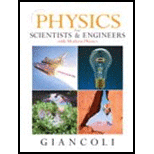
Physics for Scientists and Engineers with Modern Physics
4th Edition
ISBN: 9780136139225
Author: Douglas C. Giancoli
Publisher: Prentice Hall
expand_more
expand_more
format_list_bulleted
Concept explainers
Question
Chapter 44, Problem 9Q
To determine
The way that Cepheid variable stars could be used to measure the distance to galaxies.
Expert Solution & Answer
Want to see the full answer?
Check out a sample textbook solution
Students have asked these similar questions
Hi! I need help with these calculations for part i and part k for a physics Diffraction Lab. We used a slit width 0.4 mm to measure our pattern.
Examine the data and % error values in Data Table 3 where the angular displacement of the simple pendulum decreased but the mass of the pendulum bob and the length of the pendulum remained constant. Describe whether or not your data shows that the period of the pendulum depends on the angular displacement of the pendulum bob, to within a reasonable percent error.
In addition to the anyalysis of the graph, show mathematically that the slope of that line is 2π/√g . Using the slope of your line calculate the value of g and compare it to 9.8.
Chapter 44 Solutions
Physics for Scientists and Engineers with Modern Physics
Ch. 44.1 - Suppose we could place a huge mirror 1 light-year...Ch. 44.2 - Prob. 1BECh. 44.4 - What is the Schwarzschild radius for an object...Ch. 44.4 - A black hole has radius R. Its mass is...Ch. 44.9 - Prob. 1EECh. 44 - The Milky Way was once thought to be murky or...Ch. 44 - Prob. 2QCh. 44 - Prob. 3QCh. 44 - Prob. 4QCh. 44 - Prob. 5Q
Ch. 44 - Prob. 6QCh. 44 - Prob. 7QCh. 44 - Prob. 8QCh. 44 - Prob. 9QCh. 44 - Prob. 10QCh. 44 - Prob. 11QCh. 44 - Prob. 12QCh. 44 - Prob. 13QCh. 44 - Compare an explosion on Earth to the Big Bang....Ch. 44 - If nothing, not even light, escapes from a black...Ch. 44 - Prob. 16QCh. 44 - Prob. 17QCh. 44 - Explain what the 2.7-K cosmic microwave background...Ch. 44 - Prob. 19QCh. 44 - Prob. 20QCh. 44 - Prob. 21QCh. 44 - Under what circumstances would the universe...Ch. 44 - Prob. 23QCh. 44 - Prob. 24QCh. 44 - Prob. 1PCh. 44 - Prob. 2PCh. 44 - Prob. 3PCh. 44 - Prob. 4PCh. 44 - Prob. 5PCh. 44 - Prob. 6PCh. 44 - (II) What is the relative brightness of the Sun as...Ch. 44 - Prob. 8PCh. 44 - Prob. 9PCh. 44 - Prob. 10PCh. 44 - Prob. 11PCh. 44 - Prob. 12PCh. 44 - Prob. 13PCh. 44 - Prob. 14PCh. 44 - Prob. 15PCh. 44 - Prob. 16PCh. 44 - Prob. 17PCh. 44 - Prob. 18PCh. 44 - Prob. 19PCh. 44 - Prob. 20PCh. 44 - Prob. 21PCh. 44 - Prob. 22PCh. 44 - Prob. 23PCh. 44 - Prob. 24PCh. 44 - Prob. 25PCh. 44 - Prob. 26PCh. 44 - Prob. 27PCh. 44 - Prob. 28PCh. 44 - Prob. 29PCh. 44 - Prob. 30PCh. 44 - Prob. 31PCh. 44 - (II) Calculate the peak wavelength of the CMB at...Ch. 44 - Prob. 33PCh. 44 - (II) The scale factor or the universe (average...Ch. 44 - Prob. 35PCh. 44 - Prob. 36PCh. 44 - Prob. 37GPCh. 44 - Prob. 38GPCh. 44 - Prob. 39GPCh. 44 - Prob. 40GPCh. 44 - Prob. 41GPCh. 44 - Prob. 42GPCh. 44 - Prob. 43GPCh. 44 - Prob. 44GPCh. 44 - Prob. 45GPCh. 44 - Prob. 46GPCh. 44 - Prob. 47GPCh. 44 - Prob. 48GPCh. 44 - Prob. 49GPCh. 44 - Prob. 50GPCh. 44 - Calculate the Schwarzschild radius using a...Ch. 44 - How large would the Sun be if its density equaled...Ch. 44 - Prob. 53GPCh. 44 - (a) Use special relativity and Newtons law of...Ch. 44 - Prob. 55GPCh. 44 - Prob. 56GPCh. 44 - Prob. 57GPCh. 44 - Prob. 58GP
Knowledge Booster
Learn more about
Need a deep-dive on the concept behind this application? Look no further. Learn more about this topic, physics and related others by exploring similar questions and additional content below.Similar questions
- An object is placed 24.1 cm to the left of a diverging lens (f = -6.51 cm). A concave mirror (f= 14.8 cm) is placed 30.2 cm to the right of the lens to form an image of the first image formed by the lens. Find the final image distance, measured relative to the mirror. (b) Is the final image real or virtual? (c) Is the final image upright or inverted with respect to the original object?arrow_forwardConcept Simulation 26.4 provides the option of exploring the ray diagram that applies to this problem. The distance between an object and its image formed by a diverging lens is 5.90 cm. The focal length of the lens is -2.60 cm. Find (a) the image distance and (b) the object distance.arrow_forwardPls help ASAParrow_forward
arrow_back_ios
SEE MORE QUESTIONS
arrow_forward_ios
Recommended textbooks for you
 Foundations of Astronomy (MindTap Course List)PhysicsISBN:9781337399920Author:Michael A. Seeds, Dana BackmanPublisher:Cengage Learning
Foundations of Astronomy (MindTap Course List)PhysicsISBN:9781337399920Author:Michael A. Seeds, Dana BackmanPublisher:Cengage Learning Stars and Galaxies (MindTap Course List)PhysicsISBN:9781337399944Author:Michael A. SeedsPublisher:Cengage Learning
Stars and Galaxies (MindTap Course List)PhysicsISBN:9781337399944Author:Michael A. SeedsPublisher:Cengage Learning
 College PhysicsPhysicsISBN:9781305952300Author:Raymond A. Serway, Chris VuillePublisher:Cengage Learning
College PhysicsPhysicsISBN:9781305952300Author:Raymond A. Serway, Chris VuillePublisher:Cengage Learning College PhysicsPhysicsISBN:9781285737027Author:Raymond A. Serway, Chris VuillePublisher:Cengage Learning
College PhysicsPhysicsISBN:9781285737027Author:Raymond A. Serway, Chris VuillePublisher:Cengage Learning Horizons: Exploring the Universe (MindTap Course ...PhysicsISBN:9781305960961Author:Michael A. Seeds, Dana BackmanPublisher:Cengage Learning
Horizons: Exploring the Universe (MindTap Course ...PhysicsISBN:9781305960961Author:Michael A. Seeds, Dana BackmanPublisher:Cengage Learning

Foundations of Astronomy (MindTap Course List)
Physics
ISBN:9781337399920
Author:Michael A. Seeds, Dana Backman
Publisher:Cengage Learning

Stars and Galaxies (MindTap Course List)
Physics
ISBN:9781337399944
Author:Michael A. Seeds
Publisher:Cengage Learning


College Physics
Physics
ISBN:9781305952300
Author:Raymond A. Serway, Chris Vuille
Publisher:Cengage Learning

College Physics
Physics
ISBN:9781285737027
Author:Raymond A. Serway, Chris Vuille
Publisher:Cengage Learning

Horizons: Exploring the Universe (MindTap Course ...
Physics
ISBN:9781305960961
Author:Michael A. Seeds, Dana Backman
Publisher:Cengage Learning